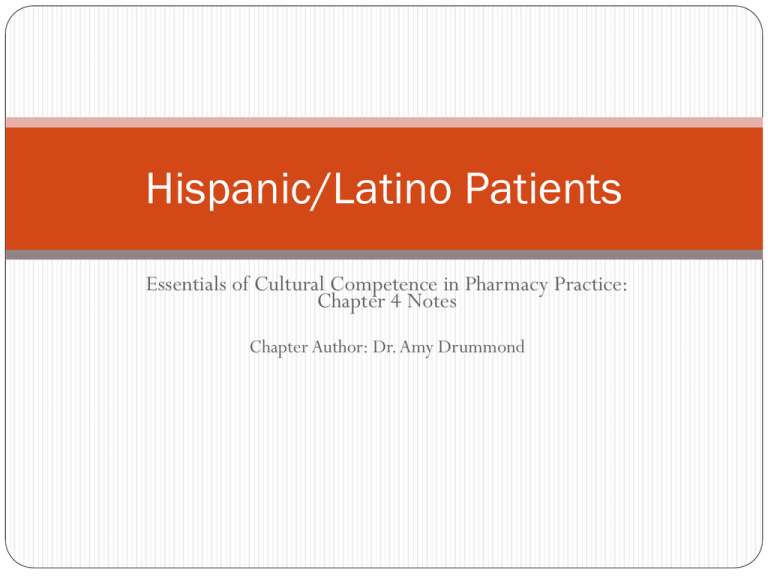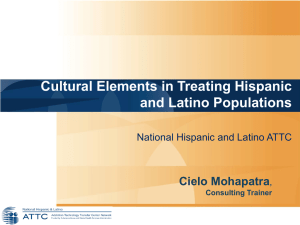
Hispanic/Latino Patients
Essentials of Cultural Competence in Pharmacy Practice:
Chapter 4 Notes
Chapter Author: Dr. Amy Drummond
Learning Objectives
1. Articulate the variability across patients who are
identified as Hispanic/Latino.
2. Recognize the role that extended family may play in the
procurement of health care.
3. Specify the health care disparities that may affect
Hispanic/Latino patients.
4. More accurately assess spirituality, illness and limited
English proficiency in patients.
Hispanic/Latino
2006 U.S. Census Bureau estimates of the Hispanic/Latino
population
The largest numbers reside in California, Texas, and Florida.
How Is Hispanic/Latino Defined?
“A person of Cuban, Mexican, Puerto Rican, South or
Central American, or other Spanish culture or origin
regardless of race.”
Based upon 2000 U.S. Census data, approximately two-thirds
of the Hispanic/Latino culture living in the United States
have identified their race as Mexican.
Immigration
Primarily for political and economic reasons.
Early 20th century: immigration due to political instability and
opportunities for economic advancement.
Depression Era: many immigrants sent back to their native
countries.
World War II: Mexican immigrants again welcomed into the United
States to assist with farm and factory labor.
Since that time, immigration from Mexico has been met with
various political views.
Communication Styles
Traditionally, Spanish was the primary language, but largely
dependent upon the individual’s country of origin.
A third generation Hispanic/Latino living within the United States
may speak only English.
In regions of Hispanic/Latino inhabitation that have strong French
and Native American influences, French and Native American
dialects may be the primary language.
Such influences have led to some being described as co-lingual.
High Context
Greetings-a special focus on the abrazo, an embrace used to greet
those that an individual is close to.
Emotional--great emphasis on body language and touch
Communication Styles (cont’d)
During interaction with healthcare providers, people of
the Hispanic/Latino culture often do not take on active
roles in communication.
Therefore, pharmacists must be cautious that effective
communication and understanding of the rationale for
treatment occur.
Silence should not be viewed as a patient’s acceptance of
treatment.
Personalismo
Interacting in a caring manner extending beyond the
individual to their family and other aspects of their life.
The application of personalismo to interactions in
pharmacy practice may improve patient compliance.
Interpretation of Time
Loose frame of reference.
It is not uncommon for individuals to schedule meeting
times and then not arrive punctually.
When arranging meeting times, pharmacists should
ascertain if they are following the American clock or the
Latin clock.
Family Roles/Organizations
The Hispanic/Latino culture subscribes to a strong extended family
system (familismo).
Males typically work outside the home to provide financial support for
the family.
An important concept for many Hispanic/Latino males is machismo—
placing honor above all other things to preserve the male’s sense of
being.
The traditional role of females has been that of wife, mother, and
homemaker.
A larger portion of the United States work force will be made up of
Hispanic/Latino women in the future.
Hispanic/Latino culture subscribes to a strong extended family system.
Mexican American grandparents play a vital role in contributing to the
family unit.
Great respect toward elders.
Lesbian, Gay and Bisexual
Relationships
Minority sexual orientations are generally not viewed
favorably among the Hispanic/Latino population.
Strong sense of familismo.
Values of procreation, carrying on the family name, and
machismo may lead individuals to avoid disclosing their
sexual orientation.
Workforce Issues
Hispanic/Latinos born in the United States contribute to virtually
any occupation in the professional or service industry.
Foreign born Hispanic/Latinos make up a large portion of the
construction, agricultural, and service industries.
Within the work force, Mexicans may choose not to associate with
the Hispanic/Latino culture in the hopes that they will achieve
greater financial gain.
Relevant Disease States
Leading causes of death in 2002 among Hispanic/Latino individuals.
Conditions with exceptionally high rates among Hispanic/Latinos compared to
other cultural groups.
Among the Hispanic/Latino population, conditions of which Puerto Ricans have
the highest prevalence.
The prevalence of diabetes and obesity are similar between Puerto Ricans and
Mexicans.
Hispanic/Latinos tend to have a higher incidence of tuberculosis.
High Risk Behaviors
The Hispanic/Latino culture has a significantly higher incidence of human
immunodeficiency virus (HIV) compared to other groups within the
United States.
Prevalence of tobacco use in Hispanic/Latino males and females.
The prevalence of smoking is lower among the Hispanic/Latino population
than the non Hispanic/Latino white population.
Data on alcohol consumption within the Hispanic/Latino population.
The rates of substance abuse do not differ significantly between
Hispanic/Latinos and non-Hispanic/Latinos.
Hispanic/Latinos were more likely to report using illicit substances when
compared to non Hispanic/Latinos.
Health
Seeking
Behaviors
Hispanic/Latino men tend to seek care when they are unable to carry out their
occupational responsibilities.
Hispanic/Latino women tend to seek health care for the family and often place
their family’s needs before their own.
Lack of insurance coverage may limit seeking health care.
When significant healthcare decisions need to be made, many family members may be
involved with the ultimate decision being made by the elder male family member. This may
present challenges to the pharmacist when trying to maintain privacy standards.
Nutrition
It is difficult to generalize nutritional intake based upon availability of local
foods.
Typical components of the traditional Hispanic/Latino diet are high in
intake of plantains, beans, rice, and poultry and low with regard to most
fruits and vegetables.
Food is an important part of the traditional culture.
Pregnancy/Childbearing/Childrearing
Familismo has contributed to the development of large families among many
Hispanic/Latinos. Engaging in the maternal role may be a core value for many
women.
Catholicism--A high percentage of Hispanic/Latinos are Catholic.
The maternal role may be changing from the traditional homemaker with child
rearing responsibilities as more Hispanic/Latina women enter the work force.
Practices associated with newborn care.
Pregnancy/Childbearing/Childrearing
Infants born to Hispanic/Latino women tend to have low mortality rates.
Less than 80% of Hispanic/Latina women begin to receive prenatal care during the first
trimester.
Common belief that life is determined by fate. Consequently, it is difficult to proactively
influence a pregnant woman to make lifestyle changes.
Within the Hispanic/Latino culture, it is expected that health care providers
demonstrate great respect toward women, and especially pregnant women.
Some women prefer to have only females involved in their care.
After giving birth, some women may wish to bury the placenta.
During the postpartum period, the mother may observe La Cuarentena, a time period of
nearly six weeks in which the mother limits physical activity and focuses on caring for
herself and her newborn and the father becomes engaged in his paternal role.
Spirituality
Spirituality is deeply rooted within the Hispanic/Latino culture. The primary
religion among the Hispanic/Latino culture is Roman Catholic.
Various depictions of the Virgin of Guadalupe.
Spirituality among a group of Hispanic/Latina women.
The meaning of life follows the core values associated with family discussed
earlier.
Hot/Cold
A belief that health is in a state of balance when equilibrium exists
between “hot” and “cold”.
Hot diseases are treated with cold remedies and nutritional intake,
and cold diseases are treated with hot remedies or nutritional intake.
The “hot” and “cold” is not referring to the temperature of the
patient, remedy, or nutritional source.
Traditional Healers
yerberos focus upon herbal therapy.
parteras practice as midwives.
sobadores practice involves massage therapy.
curanderos practice curanderisomo and are able to treat a
multitude of symptoms.
Antibiotics
Antibiotics can be easily obtained without a prescription or other medical
intervention.
A study found that more Hispanic/Latino parents felt that antibiotics were
a required treatment for their offspring as compared to nonHispanic/Latino whites.
A study in New York City conducted in 2004 indicates that in a
Hispanic/Latino area surveyed, antibiotics were available without a
prescription in all of the grocery stores.
Even in the United States there are opportunities for patients to obtain
antibiotics without seeking medical care.
Pain
Management
Less than optimal.
Beliefs about pain
The culture may also rely upon prayer and alternative therapies to obtain pain relief.
Cancer patients may not follow the health care provider’s recommended pain therapy
regimen.
Role of Healthcare Practitioners
Traditional healers are expected to be qualified and interact with
close, personable behavior toward their patient.
The healer is following their “calling,” which indicates a deep sense
of spirituality.
Health care providers are well respected within the
Hispanic/Latino culture.
Hispanic/Latinos seek physicians from their own culture.
Reflection Questions
1. How might the concept of personalismo affect the patient
counseling you provide?
2. As a pharmacist, how will you work with Hispanic/Latino
patients to mitigate known health disparities?
3. How will you use the information contained in this chapter
to inform your practice?






